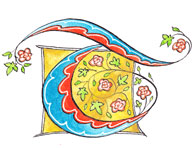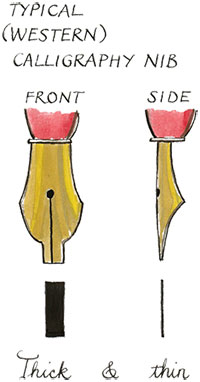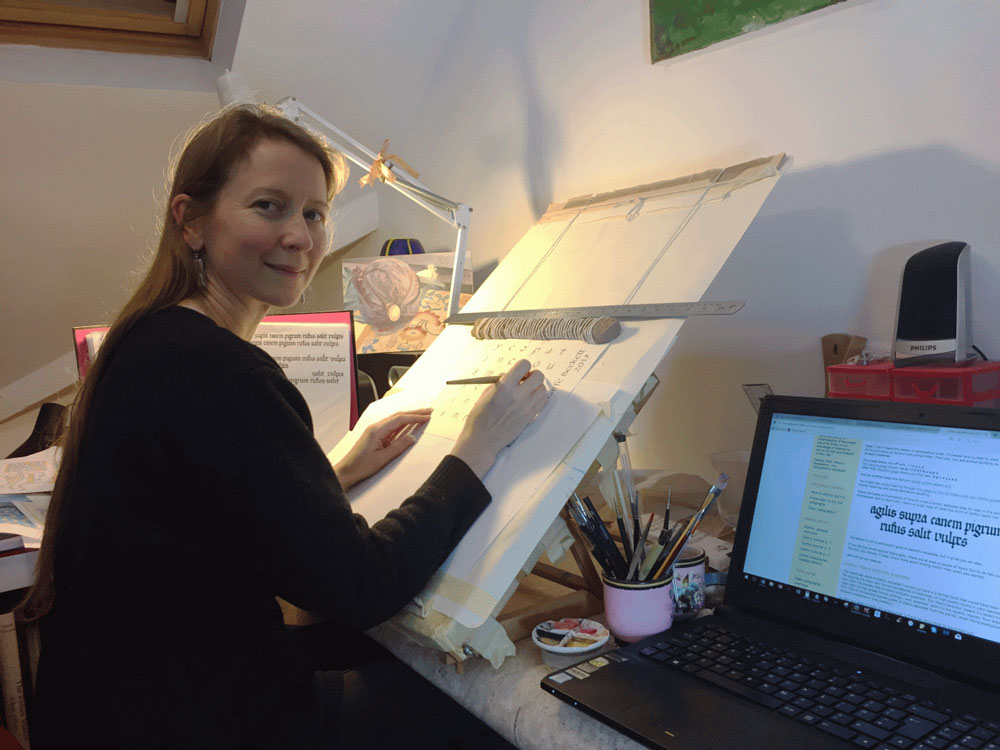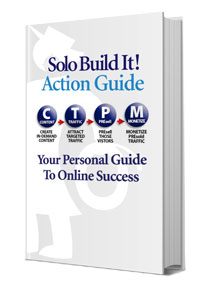
The thing I enjoy the most is the pure satisfaction of converting calligraphy into cash – the excitement of knowing that my personal enjoyment and interest in letterforms and helping others improve their calligraphy can be expressed in words and images which sit out there on a web page and generate income while I’m asleep.Katharine Scarfe Beckett from calligraphy-skills.com
Since early childhood, Katharine Scarfe Beckett’s two biggest passions were writing and art. When, at the tender age of 7, she tagged along after school to “calligraphy class,” her fate was sealed. She’d found it — the perfect union of writing and art.
 Throughout school, college and her PhD studies, Katharine kept practicing and learning more about calligraphy. Her skills didn’t go unnoticed. She was commissioned to produce calligraphy artwork for books, greeting cards and personalized gifts. Among her customers were royalty, ambassadors, political, religious and business leaders around the world.
Throughout school, college and her PhD studies, Katharine kept practicing and learning more about calligraphy. Her skills didn’t go unnoticed. She was commissioned to produce calligraphy artwork for books, greeting cards and personalized gifts. Among her customers were royalty, ambassadors, political, religious and business leaders around the world.
With such an illustrious clientele, why didn’t Katharine pursue a career as a professional calligrapher? Why did she instead choose to teach others and generously share her formidable skills — mostly for free — with a global audience? That’s what we are about to find out!
1. Katharine, despite (or perhaps because of) your deep passion for calligraphy, you didn’t pursue a career as a professional calligrapher. Instead, you built www.calligraphy-skills.com. Can you tell us more about that?
‘Because of’ is about right. I don’t much like trying to force creativity into a nine-to-five every day.
I learned my first calligraphy at age seven, and I’ve been selling my calligraphy since I was fourteen – birthday cards, wedding invitations, certificates, presentation pieces and so forth. By word of mouth, I also got work delivering workshops and lessons.
 As my skills have increased, so have my fees. And my commissioned calligraphy and artwork has ended up in the hands of princes and duchesses, authors and opinion leaders, and good friends, which I am proud of.
As my skills have increased, so have my fees. And my commissioned calligraphy and artwork has ended up in the hands of princes and duchesses, authors and opinion leaders, and good friends, which I am proud of.
But being a self-taught, part-time, semi-professional calligrapher never provided a reliable income, and I couldn’t charge my market enough to cover the time it took to do a good job. It was utterly unscalable! So I have maintained my passion for calligraphy, along with miniature-painting, as a sideline. I did it (and still do) alongside my regular writing and editing work which is paid by the hour.

At a certain point along the way I realised two things about the internet. It was a way (a) to earn steady, passive income and (b) to provide useful, needed information and skills to an audience according to their demand.
It was a way to put together my passion for calligraphy with others’ interest – beyond the constraints of ‘I’m in England, she’s in Hong Kong’. I saw the potential in that. I’d love eventually to have put all my own knowledge about calligraphy in one place so that others can use it if it’s useful to them. SBI! gives me a way to do that profitably.
Is it easy to do? Nope. Is it doable at all? Very much so, if you have the right combination of tools, guidance and support.
2. What were your initial goals when you started www.calligraphy-skills.com? Have these goals changed over time?
My initial goal was to achieve any passive income at all from calligraphy. Anything which didn’t require me to sit at the desk to try to make a reasonable income per hour. That was it. That already looked like a unicorn. (Steady income from the arts is quite a goal.)
 Still, vaguely, in the back of my mind I was aware that I might also use SBI! to put some income in place for my later years when I would really not want anymore to pull all-nighters doing ‘urgent edits’ on my laptop.
Still, vaguely, in the back of my mind I was aware that I might also use SBI! to put some income in place for my later years when I would really not want anymore to pull all-nighters doing ‘urgent edits’ on my laptop.
My goals have changed. One of the worst things that happened to me was that I set too low a goal and then achieved it. And then didn’t know what to do, and didn’t have the nerve to abandon that achievement for a better goal.
But now I’m working out how to simultaneously bring my income more under my own control, improve my offering to my visitors, and get an edge on the competition by introducing new content and revenue streams.
Luckily, when you are an SBI! member, you have two great places to turn to for guidance and inspiration:
1) The Solo Build It! Action Guide
As your smart partner in business, the Action Guide “coaches” you during every step of your online business journey. It helps you define and develop your best site concept. It shows you how to evaluate a niche’s profitability. It teaches you how to create content that gets found. It enables you to grow traffic from a variety of sources. It helps you plan and implement the best ways to monetize that traffic.
So, in Katharine’s case, to help her set new and bigger goals for calligraphy-skills.com, she would specifically revisit DAYS 4 and 10 of the Action Guide. These two DAYS (or chapters) are focused on researching and implementing different monetization methods, from fully passive (like Google Adsense or affiliate marketing) to fully active (like selling your own products or services).
There is nothing better than asking a group of people for help and receiving what you need right away. SBIers have been called “the most helpful group of individuals in the world.” Or, as long term SBI! member Tracy Scorzafava puts it…
The forums are indispensable. It’s a safe place to discuss issues you may be having with your site, ask for help, and give your input on someone else’s questions. It really does feel like a family that truly understands what you are doing. And that shouldn’t be taken lightly because none of my offline family or friends really understands what I do on a daily basis. I have never felt alone in my online ventures.
3. Tell us about your philosophy regarding content. How do you know what your prospective customers are looking for? Where does this information come from?
This is a very interesting question. Finding the right balance between what visitors want to read and what I want to write is a challenge.
My philosophy regarding content is shaped by a basic principle in the Solo Build It! Action Guide that I continually refer to: that the brilliant minds who spend their days refining and honing the world’s most advanced search engines are trying their hardest to make them able to think like human beings.
So, simply, we should write very well for our visitors. The search engines can evolve only into increasing certainty that such a site is just what these visitors are looking for.
Instead of providing the best possible content for the human visitor, the SEO school of thought focuses on “optimizing” a page’s content for the search engines. This often includes manipulation and “black hat” techniques to trick the search engines. In the long run, and as the search engines are getting smarter, these techniques can only fail.
SBI!’s philosophy has always been to “keep it real” and “add value.” Create your content first and foremost for your visitor. When they love your content, the search engines will, too.
That doesn’t mean to ignore search engines when you create content. On the contrary, the engines (or rather the people who use the search engine to find answers to whatever questions they have) play a big role in deciding what to write about.
Katharine lists 3 factors that influence her content creation…
Regarding calligraphy skills content, I see three factors:
- what people think they want and therefore what they search for
- what people actually need in order to improve their calligraphy skills
- the particular nature of my own knowledge and approach – my advantages and limitations as a source of information and teaching.
From those three factors, hopefully, emerges an answer, which is what is going to be good for the website – to make it useful to visitors, visible to search engines, and true to my voice.
 In terms of how I know what my prospective customers are looking for, I try to start where my visitors are, with what they are looking for: that has meant many, many hours with Brainstorm It!. I purchased extra credits for searches when I was pretty broke and it looked like quite an investment, and I’ve never regretted that. I regularly re-searched and refined my keyword list to guide me in my content creation.
In terms of how I know what my prospective customers are looking for, I try to start where my visitors are, with what they are looking for: that has meant many, many hours with Brainstorm It!. I purchased extra credits for searches when I was pretty broke and it looked like quite an investment, and I’ve never regretted that. I regularly re-searched and refined my keyword list to guide me in my content creation.
I also used the Google AdWords keyword tool to see what they thought of various search terms. And then I’d run my own more obscure searches for some aspect of calligraphy I was interested in myself and I’d see what I could find. I’d compare the sites that I respected and could learn from with the sites that came up when I put in my Brainstorm It! keywords.
 That gave me a kind of index of what’s out there, and also a sense of how online amateur calligraphers think. It’s not the whole answer but it proved a reliable foundation.
That gave me a kind of index of what’s out there, and also a sense of how online amateur calligraphers think. It’s not the whole answer but it proved a reliable foundation.
In terms of writing the content, I write as myself – while recognising that that isn’t going to be to everyone’s taste! I tend to write long, so I have to consider how that fits with mobile and online attention span.
But I myself really appreciate long, informative, old-fashioned pages with plenty of explanation and plenty of images, and so I tend to favour that mode. Honestly, I’m willing to lose some readers who want ‘fast and dirty’ info for the sake of the lovely, interesting people who’ll take the time to write in and thank me for talking to them like a real person.
Ultimately, I want Calligraphy-Skills.com to be the site that I would want to find if I was teaching myself calligraphy.

Brainstorm It! not only finds way more search terms that you could ever think up, it also returns supply and demand numbers to point out which topics you should write about.
But, no matter how sophisticated a keyword tool is, it cannot think. So you need to evaluate the topics and numbers that Brainstorm It! (or any other tool, like AdWords Keyword Planner) brings back based on your intimate niche knowledge.
In other words, don’t become number bound. Apply your human judgement in the final decision as to whether writing about a certain topic makes sense for your visitors.
By the way, there are more than enough search credits included in your SBI! subscription to cover your initial brainstorming. As you expand your business, you may want to do additional searches, which you can purchase for a low cost. Most SBIers don’t need this, but – as Katharine points out – if you do, you won’t regret the extra small expense.
 Katharine touches on another aspect of content writing. She says “I write as myself.” She prefers to write long pages with lots of information and images over shorter “snackable” content, even if that means losing some visitors.
Katharine touches on another aspect of content writing. She says “I write as myself.” She prefers to write long pages with lots of information and images over shorter “snackable” content, even if that means losing some visitors.
That’s what we call “writing in your voice.” You can never please everyone, so don’t even try. Instead, let your personality shine through your content. The right part of your audience will connect with you on a much deeper level if they get to know you as a real human being rather than some bland, WikiPedia style information provider.
Want to learn more about how to develop your unique voice when writing for the web? Our free eBook Make Your Content PREsell! is just the resource you need!
4. How many different income streams do you have? Which ones perform best?
I have three: AdSense, and two affiliate relationships, with Amazon and Dick Blick art supplies. They’re all small income streams but they’re all steady.
AdSense performs best month on month. The others have potential but I’m also realizing various limitations and thinking (slowly) about new income streams which will be more under my own control.
It means a lot of work but the payoff will be worth it, both literally and metaphorically.
A few years ago, you could make good money with these methods, even with moderate traffic numbers. Nowadays, you need a ton of traffic to make a decent income. And even then you are at the mercy of Google, Amazon and other affiliate companies.
Katharine realized this. Now she’s slowly working her way up to implementing additional income streams that will be more under her control and have a higher profit margin. What kind of income streams? We’ll get back to that in her answer to question 6.

5. How long did it take to start earning income from your online business? Is it a full-time or a part-time income?
I followed the SBI! Action Guide and it happened pretty much as predicted. Just bear in mind that many fellow SBI! members move faster than I did.
The first income was a few AdSense pennies one day, which was terribly exciting. I would have to look it up … OK, here we are: Friday, September 24, 2010: nineteen English pence. Yay! The historic moment when I earned myself almost exactly two dimes to rub together. That took a long time.
My very first traffic report is from two years earlier in November 2008 when, according to the SBI! traffic stats, I had nine visitors per day. By the time I was earning nineteen pennies I had around fifty pages and my traffic was up to about 300 per day. After that the income climbed steadily: on occasion, I’ve made nearly ninety times that in a day, without adding pages.
How long does it take you to get there? That depends on your niche (the more competitive it is, the longer it will take for your pages to rank) and on your time availability (if you work full-time on your business, you’ll get there much faster than if you only have a few hours per week).
It took Katharine almost 2 years to make her first income. She could have added AdSense ads a bit earlier. We typically advise SBIers to start monetizing when they have at least 25 pages of high value content and a steady stream of about 100 visitors per day.
Overall, Katharine’s progress towards monetization was slower than that of the average SBI! member. Partly, this was due to time constraints. But we believe that Katharine’s mindset played a major role in her slow monetization progress. She didn’t have a business mindset right from the start. She “set her goals too low,” as she freely admits.
Still, the income she’s earned so far with calligraphy-skills.com contributed vastly to her “peace of mind,” as she explains below…
If you do the math you can see that it remains very much part-time income but, since I work freelance, the great virtue of a regular income-stream is its regularity – I can count on it, and that takes pressure off. That income took hits from various algorithms but it has always steadied back up again to around the same level.
I have often not had time right away to react to Penguin or Panda or Patootie or whatever and the virtue of my slowness is that I could watch the site right itself without my direct input, which kept my cortisol levels down and gave me real faith in the Google dance: its end goal really is to sift the authentic sites from the manipulative search engine optimizers.
 Right now the site income is wavering slightly and I know I need to change things for mobile and https. I got distracted over the past couple of years with moving house, health issues, getting married and getting a family. You have to watch out for these little distractions.
Right now the site income is wavering slightly and I know I need to change things for mobile and https. I got distracted over the past couple of years with moving house, health issues, getting married and getting a family. You have to watch out for these little distractions.

Sure, it won’t progress much during that time. Depending on how strong a foundation you had built until taking the break, it may also take a hit in terms of traffic and income. But it won’t disappear completely.
Katharine’s business has survived her time-out and the various Google algorithm updates over the past years because she followed the SBI! principles – keep it real, add value – from the beginning.
Now, as she’s ready to move forward again, SBI! is right by her side, giving her the tools and guidance she needs to make her website mobile friendly and secure. To ensure that your content looks good and works well on all types of devices and screen sizes, SBI! provides fully responsive templates and a module called “Mobilize It!”.
To comply with Google’s recent push to move websites to a more secure structure (from http to https), we developed an HTTPS Conversion Tool for our members to make the switch to https as quick, painless and safe as possible.
6. You offer lots of calligraphy tutorials on your site for free. Have you considered turning those into paid online courses? If not, why not?
 Have you been reading my diary? Yes, I am considering how to introduce paid online courses in various forms. I’m still working on a lasting monetisation model for that.
Have you been reading my diary? Yes, I am considering how to introduce paid online courses in various forms. I’m still working on a lasting monetisation model for that.
But I am not going to take away the tutorials that I already offer for free. One of the items my visitors search for (and appreciate when they find it) is online tuition. Ultimately, I need something up there for people to see so that they can judge my style and know what they’ll be getting for their money if they pay for a download or a distance-learning course.
I do very much believe that, in an information world, you have to give good content away for free in order to advertise yourself.

Why haven’t I created those courses already? I think it’s a combination of wanting to be convinced over time about which content really works, and just being a slow thinker when it comes to developing a product of my own that I’m going to charge money for.
I’m a worker-by-the-hour, and concepts like scalability and marginal costs and minimum viable product percolate through my skull very slowly.
(I feel like I’m setting you up pretty well for the revelation that I am literally a tortoise. You know how, on the internet, no-one can tell…?)
First, you provide the Content that prospective customers in your niche are looking for. Your high-quality topical content gets found (search) or discovered (social), attracting free targeted Traffic (aka interested visitors). Once on the page, your visitors are hooked because you OVERdeliver; you present the best possible answer to what your visitors are looking for, in a unique “been there, done that” voice.
This PREsold visitor loves your free content so much that she is happy to exchange some of her hard-earned money for your paid products or services. You Monetize!
How-to topics like Katharine’s are ideal for offering tutorials and online courses as paid products. She could, for example, turn some of the tutorials she has already on her site, into a free 5 to 7 part email course. This free course would act as a “lead magnet” to grow a subscriber list of people interested in her teachings. She can then market her paid course(s) to her subscribers.
Need some inspiration how to best implement and use an email course (also called autoresponder series) to increase traffic and sales? Check out our article “Chickens By Email? How an Auto-Responder Series Helped this Solopreneur Rise to the Top of her Niche.”
7. What has been your biggest challenge so far as a solopreneur?
Well! There have been some big ones. Can I give you the top three? And I will be extremely honest.
Challenge #1: Doubt leading to sloth or, perhaps, sloth leading to doubt.
 I don’t feel like a natural entrepreneur. I was driven to entrepreneurial activity by my burning desire for any kind of freedom to make steady money from the arts. So I sometimes find I’m using ‘Oh, well, I just lack BAM’ to avoid the next tough decision.
I don’t feel like a natural entrepreneur. I was driven to entrepreneurial activity by my burning desire for any kind of freedom to make steady money from the arts. So I sometimes find I’m using ‘Oh, well, I just lack BAM’ to avoid the next tough decision.
Meanwhile life makes its usual urgent and important demands; paying clients always seem to require your time and attention first; and ‘it’s only my website and it’s not all that’. That insidious self-sabotage can be tough to challenge head-on. I recommend Ken Evoy’s ‘Why People Fail’ which is, to put it politely, a bracing read.
Challenge #2: Getting over my own earnings. Seriously.
I’ve mentioned this a couple of times: I only recently realised it. It was such a shock to the system to make any passive income at all from calligraphy that for years I have meekly settled for the good instead of pursuing the better. Do not make this mistake.
Challenge #3: Keeping up.
Reading the weekly info, staying in touch on the forums, doing the work, re-studying the Action Guide. It is a full-time job to do it properly and I do throw my hands up from time to time.
Brain – you have experience/knowledge in a field that others would want
Attitude – you have a positive attitude/ability to bounce back, and
Motivation – you persist, hanging in until you win.
From what Katharine has told us so far, it doesn’t seem like she lacks any of these three ingredients. It’s more likely that she got in her own way of achieving the success she deserves. In the “Why People Fail” booklet mentioned by Katharine, Ken Evoy describes 10+ personality types and attributes that will doom you to failure if left unchecked.
The good news? Once your realize one or more of these self-sabotaging patterns in yourself, you can overcome them. Intrigued to learn more? Here’s that download link to “Why People Fail” again.
8. What do you enjoy most about being an online business owner? How has it changed you, your life, your family?
The thing I enjoy the most is the pure satisfaction of converting calligraphy into cash – the excitement of knowing that my personal enjoyment and interest in letterforms and helping others improve their calligraphy can be expressed in words and images which sit out there on a web page and generate income while I’m asleep.
It still blows me away. It makes me able to communicate far beyond my physical limitations, and I love communicating. I find that exhilarating.
 Related to that, offsetting my sense that I sometimes get in my own way, I really enjoy knowing what I’m doing. The Action Guide is daunting, no doubt about it. But it works. You do have to study it, understand it, and then (as it is an action guide) apply it, in detail.
Related to that, offsetting my sense that I sometimes get in my own way, I really enjoy knowing what I’m doing. The Action Guide is daunting, no doubt about it. But it works. You do have to study it, understand it, and then (as it is an action guide) apply it, in detail.
So it is no picnic. But as a teacher and student I know that there is no substitute for knowing what you are doing. That sense of certainty is available through the Action Guide. So hats off. It is a brilliant piece of work.
In terms of family life, SBI! opens your eyes to the possibilities out there for children, friends, parents who could do something similar. It frees you up from thinking, ‘You have to have a day-job, you have to have a career’ and lets you think about different ways that a valuable, earning life can work out.
More immediately in terms of my own family and their quality of life, the extra income means every week I have a big box of organic fruit and vegetables delivered fresh to the door from a local farm – along with a few other high-ticket food items for the family.
I save up leftover money for my own art courses every year. I get a lot of credit for maintaining the quality of our nutrition. So even a relatively small part-time income, leveraged, makes a very direct difference to quality of life.
- The satisfaction that you’ve created something of value to yourself and countless other people all over the world out of nothing.
- The satisfaction that you’ve gained the equivalent of a college degree in business (for a fraction of the cost) by following and applying the SBI! Action Guide process.
- The satisfaction that you’ll pass on invaluable career advice to your children, other family members or friends… yes, there are viable alternatives to the traditional 9-to-5 job!
9. And finally… What’s your top tip for someone who is just starting a solopreneur career?
Persist.
Persist.
Persist, persist, persist.
(Sleep. Eat. Be nice.)
Persist.
“Nothing in this world can take the place of persistence.
Talent will not; nothing is more common than unsuccessful people with talent.
Genius will not; unrewarded genius is almost a proverb.
Education will not; the world is full of educated derelicts.
Persistence and determination alone are omnipotent.”

Latest posts by Margit Streifeneder (see all)
- From Concierge to Global Tours: 10 Lessons for Travel Business Growth - December 19, 2024
- Start an Online Business From Your Kitchen Table - November 13, 2024
- What Search Intent Is And Why It’s Important for Ranking - September 20, 2024

